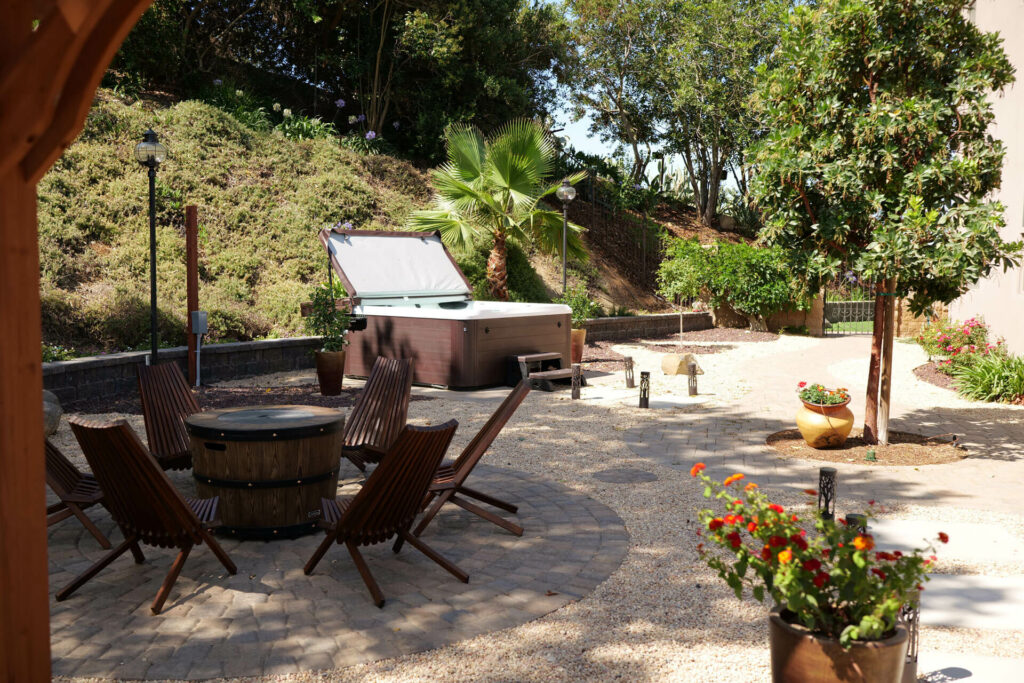Xeriscaping, a landscaping philosophy that reduces or eliminates the need for supplemental water from irrigation, is particularly relevant to San Diego due to its semi-arid climate. This approach, which originated in the western United States in response to water scarcity, involves selecting drought-resistant plants, improving soil to retain moisture, and designing landscapes to minimize water use and maximize efficiency. Here, we will explore the advantages and disadvantages of adopting xeriscaping in San Diego.
Pros of Xeriscaping in San Diego
1. Water Conservation
One of the most significant benefits of xeriscaping your backyard and front yard is the substantial reduction in water usage. In San Diego, where drought conditions are a recurrent concern, xeriscaping can help conserve water by utilizing plants that are adapted to dry conditions and require minimal irrigation beyond natural rainfall. This not only helps in preserving a precious resource but also supports the region’s water sustainability goals.
2. Reduced Maintenance
Xeriscaped landscapes typically require less maintenance than traditional lawns. Drought-tolerant plants used in xeriscaping often need less pruning, weeding, and fertilization. This reduction in maintenance can save homeowners time and money, making xeriscaping an attractive option for those looking for low-care garden solutions.
3. Cost Savings
The reduction in water usage leads to significant cost savings on water bills. Additionally, the decreased need for maintenance, lawn care equipment, and fertilizers further reduces the overall costs of landscaping over time. These savings can be particularly appealing in areas like San Diego, where water prices are high due to the scarcity of resources.
4. Environmental Benefits
Xeriscaping has several environmental benefits. By reducing the need for irrigation, it lessens the strain on municipal water supplies and natural water bodies. Furthermore, by selecting native plants, xeriscaping can support local biodiversity, providing habitats for native wildlife. The reduction in chemical fertilizers and pesticides also means fewer pollutants entering the water system, contributing to a healthier ecosystem.
5. Aesthetic Diversity
Xeriscaping offers a wide range of design possibilities, from desert-themed landscapes to lush, drought-tolerant gardens. This flexibility allows homeowners to create unique, visually appealing outdoor spaces that reflect their personal style while being adapted to the local climate. The use of native plants can also enhance the natural beauty of the area, blending built environments with the surrounding ecosystem.
Cons of Xeriscaping in San Diego
1. Initial Costs
While xeriscaping can lead to long-term savings, the initial costs can be higher than those for traditional landscaping. The expense of removing an existing lawn, improving soil, and purchasing drought-resistant plants can add up. However, these costs must be weighed against the long-term savings on water and maintenance.
2. Limited Plant Selection
The focus on drought-resistant and native plants can limit the variety of plants available for landscaping. Those who desire lush, green lawns or have a preference for non-native, water-intensive plants may find xeriscaping’s plant palette too restrictive.
3. Misconceptions
There is a common misconception that xeriscaping means a stark, rocky landscape with few plants. This misunderstanding can deter some homeowners from considering xeriscaping. Education and awareness efforts are needed to showcase the diversity and beauty of xeriscaped gardens.
4. Soil Amendment
In some cases, soil in San Diego may need significant amendment to support xeriscaping. Improving soil for better water retention and drainage can require additional effort and resources, potentially complicating the transition to a xeriscaped garden.
5. Cultural Resistance
Traditional lawns are deeply ingrained in American culture, and some may resist xeriscaping because it deviates from this norm. Overcoming cultural preferences and encouraging a shift towards more sustainable landscaping practices can be challenging.
Xeriscaping in San Diego offers a compelling blend of environmental, economic, and aesthetic benefits, particularly relevant in the context of water scarcity and climate change. While there are challenges, including initial costs and cultural resistance, the long-term advantages of water conservation, reduced maintenance, and cost savings present a strong case for adopting xeriscaping. As awareness grows and more homeowners embrace this sustainable landscaping approach, xeriscaping has the potential to transform urban and suburban landscapes in San Diego, making them more resilient and in harmony with the natural environment.






